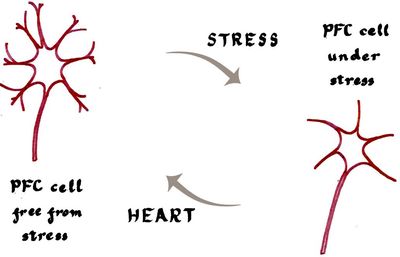The Prefrontal Cortex
The brain region most responsible for keeping the mind in “creative mode” is the prefrontal cortex (PFC) - a brain area with nerve connections with the heart.
Significantly, the PFC has long been established as critical to calming down stress, and has a rich neural connection to the organ most traditionally associated with such creative attributes as courage and joy - the heart.
Thanks to neuroscientist António Damásio and his book Descartes’ Error (1994), the PFC came to wider attention as a brain area where feelings (“affect”) combine with - and strengthen - thinking (“cognition”).
Fast forward to 2012, and the theme was developed further in The Emotional Life of Your Brain by another eminent neuroscientist, Richard Davidson. This book highlighted the true importance of the PFC. Echoing Damásio, Davidson concluded that this brain area acts as a “convergence zone for affect and cognition”. For Davidson, the PFC:
1) Plays a leading role in lending us emotional resilience, so allowing us to recover quickly from setbacks. Key, here, is the PFC’s ability to rein in the stress hormone cortisol, and calm down the amygdala (the “threat recognition centre”).
2) Grants us the ability to focus our attention, yet in such a way as to maintain an “open, nonjugdmental awareness” so that we can “pick up on... subtle cues”, but “without getting stuck on any one stimulus to the detriment of the others”. This is essential in offsetting stress’s tendency to keep us tunnel-visioned or distracted by fear and anger etc.. Only with true attention - backed up by the PFC - can we truly sense and experience, and sustain complex learning and decision-making.
3) Supports our positive outlook through its connection to the nucleus accumbens (NAc).
The NAc plays a role in motivation and helps generate a pleasure and reward that we perceive, and is full of the brain chemical dopamine. Brain signals from the prefrontal cortex bathe the NAc in dopamine independently of stress biology, and so allow us to be treated to our feel-good dopamine without being bullied by the threat of c. desire shutting off its dopamine supply (that, incidentally, is delivered by nerve cells originating in the so-called ventral tegmental area).
*
If the PFC - together, perhaps, with the heart - work jointly in taming stress, stress has been shown to be detrimental to PFC functioning.
- Among adolescents, for example, anxiety was found to be associated with PFC suppression and working memory impairment.
- Meanwhile, in babies, stress has been found to restrict the growth of the nerve cell branches needed for healthy PFC functioning.

